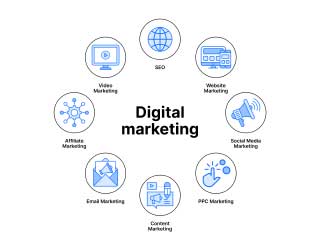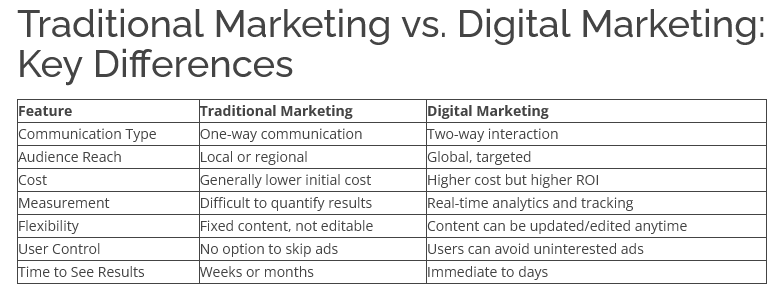How Digital Marketing Works

What is Digital Marketing? Strategies, Tools & Trends in 2025
Understand how modern digital marketing strategies work to grow your brand in 2025
How Digital Marketing Works
Digital marketing uses digital channels like websites, search engines, and social media to connect with customers. It combines strategies such as SEO, PPC, content creation, and analytics to drive online growth.
Key Components of Digital Marketing in 2025
1. Define Goals and Audience
Clarify your marketing objectives and identify your target audience for effective campaign performance and personalization.
2. SEO and SEM
Optimize your site with SEO best practices and run PPC campaigns to increase visibility in search engine results and attract high-converting traffic.
3. Content Marketing
Create blog posts, videos, and guides that solve problems and provide value. High-quality content improves engagement and boosts SEO.
4. Social Media Marketing
Use platforms like Instagram, LinkedIn, and Facebook to engage with audiences, run ads, and increase brand awareness and loyalty.
5. Email Marketing
Build lists and send personalized, value-driven content to nurture leads and convert prospects with newsletters and promotions.
6. Influencer Marketing
Partner with niche influencers to reach targeted followers, boost credibility, and expand brand visibility across digital platforms.
7. Analytics and Optimization
Track KPIs with tools like Google Analytics, refine your strategy, and continuously improve campaign performance and ROI.
Why Digital Marketing Matters in 2025
In a highly competitive digital economy, effective online marketing is essential for lead generation, brand authority, and business growth.

Comparison Between Traditional Marketing and Digital Marketing
Let’s understand the terminology of traditional marketing and digital marketing to help you decide which marketing strategy suits your business.
What is Traditional Marketing?
Traditional marketing refers to the well-established methods of purchasing and selling goods and services using offline channels. Historically, human society progressed from barter systems to trading and marketing. Traditional marketing involves techniques such as:
- Billboards and signboards
- Flyers and newspapers
- Television and radio commercials
- Posters and broadcasts
- Door-to-door sales and sponsorships
While traditional marketing is generally less expensive upfront, it is often less effective at building brand awareness and hard to measure in terms of ROI. It targets local audiences with one-way communication and shows results over weeks or months. Moreover, users have no control over the ads they see.
What is Digital Marketing?
Digital marketing moves faster than traditional methods and involves promoting products or services via electronic channels. The term “digital” comes from the binary system (0s and 1s) used by computers. Digital marketing channels include:
- Email marketing campaigns
- Search engine optimization (SEO)
- Social media marketing on platforms like Facebook, Instagram, Twitter, and LinkedIn
- Pay-per-click (PPC) advertising
Known as the “father of digital marketing,” Philip Kotler laid the foundation of modern marketing strategies. Digital marketing is costlier but highly efficient for brand promotion and global reach. It provides tools to:
- Analyze customer engagement and product performance
- Customize ads and marketing messages for targeted users
- Edit and update advertisements in real time
- Allow users to skip unwanted ads
Digital marketing uses two-way communication and offers quick, measurable results that improve customer satisfaction and drive business growth worldwide.
Traditional Marketing vs. Digital Marketing: Key Differences
| Feature | Traditional Marketing | Digital Marketing |
|---|---|---|
| Communication Type | One-way communication | Two-way interaction |
| Audience Reach | Local or regional | Global, targeted |
| Cost | Generally lower initial cost | Higher cost but higher ROI |
| Measurement | Difficult to quantify results | Real-time analytics and tracking |
| Flexibility | Fixed content, not editable | Content can be updated/edited anytime |
| User Control | No option to skip ads | Users can avoid uninterested ads |
| Time to See Results | Weeks or months | Immediate to days |
Conclusion
Both traditional marketing and digital marketing have their benefits depending on your business goals. Traditional marketing remains effective for businesses focusing on local markets and those comfortable with established methods. In contrast, digital marketing drives global growth and provides measurable, adaptable strategies ideal for modern businesses aiming for wider reach and customer engagement.
For startups and growing enterprises, incorporating digital marketing strategies such as SEO, social media, and online advertising is essential to stay competitive and maximize ROI.